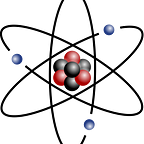QIntro: Ising Model to variational Methods
The journey from ising model to quantum variational methods
In this article, we discuss about Ising Model, Quadratic Unconstrained Binary Optimization (QUBO) model, similarities between ising and QUBO model, Adiabatic theorem, QUBO model to Quantum Variational Methods.
Ising Model:
Ising Model is used to study phase transition in Magnetic systems.
phase transition means interaction of near by spins.
In domain theory, magnetization of each individual domain is randomly oriented in absence of external field.
When we apply external field, domain walls starts collapsing and nearby domain’s form a bigger domain and magnetization, this collective domain is in the direction of applied field.
But, there is no perfect alignment due to thermal agitation. Because due to thermal energy tiny dipoles will move and hence perfect alignment does not occur.
So, two nearby domains form a collective domain due to interaction of nearby spins.
With the above theory the Hamiltonian is a representation of between spins and the external fields.
We see the Hamiltonian in the following steps.
For each lattice site k ∈ b there is a discrete variable
the discrete variables represents the site’s spin.
spin system:
Hamiltonian: E = σ1 . σ2
Let’s add one more magnet
then nearest neighbors, Hamiltonian: E = σ1 . σ2 + σ2 . σ3
Now let’s add separation between the magnets
Hamiltonian: E = ∃12 σ1 . σ2 + ∃23 σ2 . σ3
Now, let’s consider a more complex system by applying external magnetic force.
Hamiltonian: E = ∃12 σ1 . σ2 + ∃23 σ2 . σ3 + h1 σ1 + h2 σ2
coupling strength shall be negative,
The first part represents the mutual interaction of nearby spins and the second part represents the interaction of individual spin with external magnetic field.
Adiabatic Theorem:
If the Hamiltonian of a quantum system in it’s ground state is perturbed slowly enough, the system remains in it’s ground state.
Quantum Hamiltonian is an operator on Hilbert space.
it shows that first part to be in pauli x matrix and second be in pauli z matrix.
Where,
A(s) → Corresponds to Original Wave function where qubits are in up and down fashion
B(s) → the problem we want to solve
As shown below, under the adiabatic condition A(s) slowly comes to B(s) with low energy state.
adiabatic evolution with runtime T
Where,
Hc → Cost Hamiltonian
Hm → Mixer Hamiltonian
When the evolution reaches to the point t/T then H(t) remains as Cost Hamiltonian.
This can be achieved by the objective function C(x) as shown below
where x represents the binary variable.
further simplifying as shown below
we solve the problem using Schrödinger wave equation as shown below
the above expression represents the below form, so we use the trotterization method to solve the problem.
Let’s convert the spin system to bits system by using the condition 1–2xi
rewriting the above expression gives us
by replacing the binary variable with the above expression the cost function can be formulated as
by rewriting the above expression we get, as shown below
C(x) in pauli z matrix which is z basis or computational Basis state. So we apply z gates and Mixer Hamiltonian in x basis we apply x gates.
We apply variational method using rotational gates namely Rx and Rz gates.
Quadratic Unconstrained Binary Optimization (QUBO):
The set of binary vectors of a fixed length(n>0) is denoted by B power n, where B = {0, 1} is the set of binary values.
Consider a real-valued upper triangular matrix
whose entries Qij define a weight for each pair of indices i, j ∈ {1, 2, 3, … n} with in the binary vector.
We can define a function
the above function assigns a value to each binary vector through
Intuitively, the weight Qij is added if both xi and xj have value 1, when i = j, the values Qii are added if xi = 1 as xixi = xi for all xi ∈ B.
The QUBO problem consists of finding a binary vector x’ that is minimal with respect to the function.
In general, x’ is not unique, meaning there may be a set of minimizing vectors with equal value w.r.t function. The complexity of QUBO arises from the number of candidate binary vectors to be evaluated.
sometimes, QUBO is defined as the problem of maximizing function, which is equivalent to
Variational Method:
Method for approximating the ground state |ψ’⟩ and lowest energy E₀ of a quantum system.
- choose ansatz (or) trail state parameterized by θ as |ψ(θ)⟩
- vary parameters θ to minimize the energy value.
E(θ’) is an upper bound for Emin and |ψ(θ’)⟩ approximates |ψ’⟩.
We create an initial circuit which is termed as anztaz using rotational gates, then we perform the Measurement and capture Energy values, we use classical optimizer for finding the minimum energy value, by updating theta value we modify the rotation of the gates and continue the search operation until find a feasible solution.
References:
Wikipedia, Qiskit Text Book, IIT Madras Course, IBM Summer school 2021, open sources.
